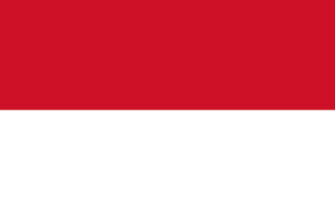Bosnia and Herzegovina is a state located on the Balkan Peninsula, in the southeastern part of Europe. The country gained its independence in 1992 after separating from Yugoslavia.
The flag of Bosnia and Herzegovina in its current form was adopted by the Parliamentary Assembly of the State on February 4, 1998.

History
When Bosnia and Herzegovina was part of Yugoslavia, its flag was a red cloth with a small flag of the federation itself in the upper left corner. Such flags were very common in the 20th century. In addition to the regions of Yugoslavia, such a principle of construction was used in the flags of the dominions of the British Empire and the republics of the USSR.

After the secession from Yugoslavia, Bosnia and Herzegovina adopted a new flag: on a white rectangular field there was a blue shield with a gold border. The shield itself was divided by a white stripe running from the upper left corner to the lower right. On either side of this band were three heraldic sword symbols. Today, this flag is considered to be obsolete (its official use has been prohibited since March 31, 2007), but it is still very popular among Bosnian nationalist and religious (Islamic) organizations.

There were originally seven designs for the national flag of Bosnia and Herzegovina.
- Project 1: a flag similar to the Czech flag, the colors representing the three major nations: Bosniacs, Croats, Serbs.
- Project 2: on a blue background, a branch of laurel — symbolizing the UN.
- Project 3: the contours of the country on a blue background.
- Project 4: a red, white and blue flag with a map of the country in the center and stars around it
- Project 5: a flag that has become official
-

Project 1 -

Project 2 -

Project 3 -

Project 4 -

Project 5 -

Project 6 -

Project 7
In the final vote in the Parliamentary Assembly there were three options: draft 5, 6 and 7, among which the blue-yellow flag with white stars was preferred.
The modern flag of Bosnia and Herzegovina is significantly different from the previous versions and has been used as the official symbol of this state since 1998.
Description
The aspect ratio (length to width) of the flag is 2:1. The main color is dark blue. On the dark blue rectangle is a yellow triangle with the apex at the bottom. Its cathetics run along the upper border of the main canvas (horizontal) and along the right side at the end of its third quarter (vertical). Along the hypotenuse of the triangle are nine white stars, the first of which represents only its lower half and the ninth only its upper half.
Colors
The flag has three colors — navy blue, yellow and white.
Meaning of colors and symbols
If we look at the geographical location of the state, we can see that Bosnia and Herzegovina is something similar to the triangle from its flag. The three sides of this triangle represent the main peoples living in the country: Bosniaks (Bosniaks), Croats and Serbs.
The blue color of the flag is a reference to the European Union and the United Nations, which played a key role in ending the Bosnian war, resulting in a peaceful and neighborly life in this country.
The stars on the flag symbolize Europe (it is also assumed that their number is infinite — hence the «half» first and ninth stars).
General information about Bosnia and Herzegovina
| Official language | Bosnian, Serbian, Croatian |
| Capital | Sarajevo |
| Territory | 51,197 km2 |
| Population | 3 511 372 people |
| Currency | convertible mark |
| Phone Code | +387 |










Как мужчина, я хочу сказать, что флаг Боснии и Герцеговины действительно уникален. Его дизайн, с одной стороны, простой, но в то же время он наполнен глубоким смыслом и историей. Звезды и треугольники символизируют разнообразие и многокультурность страны. Этот флаг отражает надежду на единство и мир среди различных этнических групп. Важно ценить, как такие символы могут объединять людей и служить напоминанием о необходимости взаимопонимания и сотрудничества.
I completely agree with you! The flag’s design really conveys a deep message, much like how my community came together during a festival. Different cultures shared traditions and food, showing that diversity can unite us. Symbols like this flag remind us to celebrate what makes us unique while fostering togetherness.
I absolutely love the flag of Bosnia and Herzegovina! The colors and symbols are so vibrant and meaningful. When I visited, I saw it flying everywhere, and it filled me with pride! It really captures the spirit of the country. Can’t wait to go back!